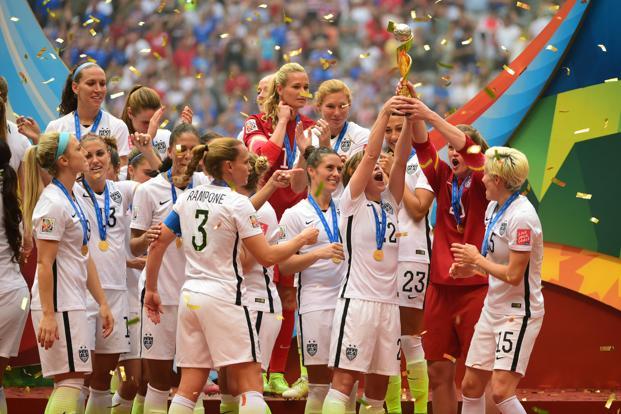Trending Now
- 830 voters names go missing in Kavundampalayam constituency
- If BJP comes to power we shall consider bringing back electoral bonds: Nirmala Sitaraman
- Monitoring at check posts between Kerala and TN intensified as bird flu gets virulent in Kerala
Columns
Women’s football: The dark side of the beautiful game
![]() February 4, 2016
February 4, 2016
Timothy Stillman
ifa estimates that more than 750 million television viewers watched at least 60 seconds of action during the 2015 women’s World Cup in Canada. The final between the US and Japan was the most watched soccer match (men’s or women’s) in US television history, with 25.4 million tuning in. Soccer is widely considered a women’s sport stateside, so perhaps these figures aren’t so surprising, especially as this was the US’s first World Cup win in 16 years.
The tournament also broke television viewing records in Canada, France, Japan, Australia, Brazil, China, South Korea and Norway for women’s football. At its pinnacle, the sport is growing rapidly. However, the “trickle down” effect into domestic women’s football is not quite so pronounced.
International football remains very much the lifeblood of the women’s game. In most countries, players are paid centrally by their associate football associations for representing their nations.
Women’s football is heavily reliant on the spectacle of international tournaments to widen its popularity. The struggle has been to sustain that interest and make it bleed into women’s club football.
Attendance often spikes in the immediate aftermath of a World Cup or Olympic Games, only to plateau again after a few months. In the English Women’s Super League, crowds quadrupled across the board in the immediate aftermath of the 2015 World Cup, with fans buoyed by the success of the Lionesses. But crowds drifted back towards the mean by the end of the domestic season in October.
Women’s World Cups fall in the “in between” years, when there is no men’s World Cup or European Championship, which makes it ripe for strong television viewing and attendance figures. International fixtures occur much more regularly in women’s football. It remains largely an amateur sport, so the pride of representing one’s country is not compromised by club salaries, as it is in the men’s game. What’s more, the women are remunerated directly with central contracts at the national level, which gives football associations greater sway over players.
In a tournament year, a successful nation can expect to play close to 20 fixtures. Even at the top level of the game, the living a female footballer can make from club and international contracts alone is not especially generous. The players in the upper echelons rely heavily on endorsements, and since international football is so much more visible, playing for one’s country increases the chances of augmenting one’s salary.
In the US, soccer is more readily accepted as a women’s sport. The sport’s history is not shrouded in the same patriarchal cultural baggage as it is in much of Europe. In recent years, other nations have risen to challenge the US’s dominance, such as Japan and Germany.
Lately, teams such as France and England have developed pleasingly while the Brazilian national side is no longer just 10 girls and Marta. The international picture is panning out to be more competitive, which will only serve to generate more interest.
The women’s game is developing at different speeds all over the world. Much of this is cultural; put simply, in some countries, the idea of women playing football is more accepted than in others, though no nation is entirely free of sexist attitudes.
Five-time Ballon D’Or winner Marta gave an interview to a Canadian publication during the World Cup in which she illustrated her struggle for basic recognition in her own country. She started her career in Rio, at Vasco da Gama, but had to leave when the club ceased operations. She then played for a small club in Minas Gerais, which also folded while she was in their employ.
In Canada, she broke a record by scoring her 15th World Cup goal, more than any other female player. Back home, national newspaper O Globo entirely ignored the feat, neglecting to mention it in its sports coverage the next day.
To make matters worse, Marco Aurelio Cunha, the coordinator for the women’s game for the Confederation of Brazilian Football, made these remarks in the wake of the tournament: “Now the women are getting more beautiful, putting on make-up. They go onto the field in an elegant manner. Women’s football used to copy men’s football. Even the jersey model, it was more masculine. We used to dress the girls as boys. So the team lacked a spirit of elegance, femininity. Now the shorts are a bit shorter, the hair styles are more done up. It’s not a woman dressed as a man.”
It’s little wonder that Marta talks openly about becoming a Swedish citizen. Sweden has been much more instrumental in the development of her football career than her home country. She has played for three Swedish clubs now and is fluent in the language.
When officials charged with the development of the women’s game in your native country are making such crass comments, there remains a good deal of cynicism to overcome. Though it is important to highlight that Cunha’s comments are not representative of those administrating women’s football, patronizing attitudes continue to germinate and find oxygen.
One must be careful not to compare women’s football with top-level men’s football. Women’s football is played in a different style, for a start. But the concept of women’s football is still in its infancy. In England, women were banned from organizing themselves professionally in football until the 1970s. Women’s football is bridging a gap of around 100 years of development compared to the men’s game.
With the template and success of men’s football, it is amending the chasm swiftly, but to measure women’s football against men’s is to disregard a century’s head start for the latter—even when one casts aside the complex gender politics that female athletes have to navigate compared to their male counterparts.
The tectonic plates of the domestic game in women’s football continue to collide. With the suffocating coverage of men’s football and the rolling soap opera of La Liga, the Premier League and the Champions League, the women’s leagues struggle to be noticed.
The most successful European sides are heavily reliant on strong corporate backing to remain competitive. More often than not, the clubs that compete in the Women’s Champions League final are on corporate dialysis, with a significant financial backer or company sustaining them. For instance, the Göteborg women’s team were renamed the Kopparbergs, after the famous cider brand.
This creates inequalities in the domestic leagues, with heavily backed teams often strolling to league titles at a canter. In France, Olympique Lyonnais Féminin has won each of the past nine league titles. Yet quite often, dynasties such as Lyon’s disappear in a puff of smoke once private individuals or companies relinquish their generosity. Between 2000 and 2008, Swedish club Umea won seven league titles and appeared in five Women’s Champions League finals, winning two of them. Yet in 2008 they were nearly liquidated, having made a loss of around $3 million.
Umea signed Marta on a wage they could scarcely afford, but were able to do so on the back of sponsorship and the interest her presence generated. When the global recession hit in 2008, companies quickly withdrew from commercial interests in Umea, leaving them saddled with a salary their income could not support. They narrowly survived bankruptcy and have not won a trophy since. They finished 11th in the 2015 season of the Swedish Damallsvenskan.
A loose comparison can be made between women’s domestic football now and men’s league football in the early 20th century, when many a team tumbled out of existence as clubs grappled with the moral and fiduciary quandary of whether to go professional or stay amateur.
In this Darwinian jungle, many clubs were singed by the heat of a game that was evolving too rapidly for them. There is a paradox at the heart of women’s football; it needs commercial revenue to survive, but often commercial interests run at odds with the integrity of the sport itself.
A Fifa spokesperson confirmed that teams were allocated to certain groups in the 2015 World Cup draw for promotional reasons. Even in the US, the bedrock of the women’s game, they have struggled to sustain a prosperous domestic league, despite a thriving scholarship system and nurturing attitude towards women’s soccer.
Just 24 hours after the US women’s team secured qualification for the 2012 Olympic Games, the Women’s Professional Soccer league was cancelled, leaving many top-level American players clubless.
The league was supported by the magicJack franchise. The controversial owner of the franchise, Dan Borislow, aired a number of grievances with the league, before eventually withdrawing funding. He took the league’s administrators to court and the Women’s Professional Soccer league was forced to suspend operations.
The top flight in the hotbed of women’s football was forced to discontinue on the whim of one man’s wallet. It isn’t the only time that a league structure has toppled stateside. In 2003, the Women’s United Soccer Association suffered a similar fate just three years after its inception.
Yet, the reality is that the majority of countries do not even have established domestic football competitions for women. All India Football Federation (AIFF) general secretary Kushal Das told Fifa in December 2014 that the aim was for a professional league to be set up in India in 2015; this failed to happen.
Most players in the Indian women’s national team hold government positions, with little prospect of ever earning enough to make a satisfying living from football, though goalkeeper Aditi Chauhan currently plies her trade for West Ham Ladies, having moved to England to study at Loughborough University.
The Women’s National Football Championship is the jewel in the crown of Indian domestic women’s football and the AIFF didn’t even bother to hold the tournament between 2011 and 2014. Administrative disinterest makes it difficult for progress.
On 7 February, the Indian national side will face Afghanistan in a friendly, the first friendly the AIFF has arranged for the team in three years. Games for the Indian side remain tediously uncompetitive, which hardly stirs up interest for spectators, or help players to progress.
India lost their last game to Myanmar 7-0 last March; prior to that they were dishing out comprehensive defeats themselves, winning their previous six games 4-0, 6-0, 5-0, 12-0, 5-1 and 8-0. Immediately before that streak began, they lost 10-0 to Thailand.
That said, the Indian women’s national side holds a higher Fifa ranking than their male counterparts. It remains a mystery that such a populous country with a consuming passion for football continues to have such an uninspiring participative legacy.
The Indian Super League was founded in 2013 with the ultimate aim of creating a flourishing domestic football scene. The women’s game in this sprawling nation requires a similar notion to put itself on the emerging map of women’s football.
Disclaimer:The views expressed above are the author’s own






















